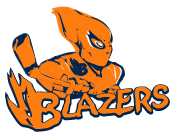Concussion Awareness
With the advent of body checking at a younger age, coaches, trainers and parents need to be more aware of concussion symptoms.
Here are some helpful hints if you suspect a player might have a concussion.
Always assess airway, breathing and circulation. All players who experience a concussion must be seen by a physician before the player can return to play.
Definition:
Change in mental state (confusion) as a result of a trauma. May involve loss of consciousness.
Mechanism:
Blow to the head, face or jaw. May result from a whiplash effect to the neck.
Types of Concussion
First Degree: Player experiences brief period of confusion. There is no loss of consciousness. Symptoms are completely gone in less than fifteen minutes.
Second Degree: Player experiences a loss of consciousness (however brief) or player
experiences symptoms beyond fifteen minutes. Player should see a physician immediately.
Common Symptoms and Signs
-Vacant Stare
-Dizziness
-Poor coordination
-Ringing in the ears
-Delayed responses to questions
-Seeing stars
-Nausea, vomiting
-Sensitivity to light
-Inability to focus
-Sensitivity to noise
-Headache
Please note that some symptoms/signs may appear later so player should be observed even after symptoms/signs seem normal.
Mental Status Testing
For information only. Do not attempt to treat a concussion.
Always have the player consult a physician.
Orientation: Does the player know what the exact time and place is? Does the player know the circumstances of the injury?
Concentration: Can the player spell “world” backwards?
Memory: Does the player know the score of the game?
Any Loss of Consciousness – Initiate Emergency
Action Plan and Call an Ambulance
-Rule out possible neck injury
-Remove the player from further play
-Do not administer medication
-Notify the parent or guardian about the injury
-The player does not return to play unless permitted to do so by a physician
Return To Play
The return to play process only begins after a physician has given the player clearance to return to activity. If any symptoms/signs return during this process, the player must be re-evaluated by a physician.
1. No activity, complete rest. Proceed to step 2 only when symptoms are gone and a physician has given the player clearance.
2. Light aerobic exercise such as walking or stationary cycling. Monitor for symptoms.
3. Sport specific training (e.g. skating).
4. Non-contact drills.
5. Full contact practices.
6. Game play.
Note: Player should proceed through the steps only when it has been demonstrated that there are no return of symptoms. This includes long term symptoms such as, fatigue, irritable behaviour or sleep disturbance. If any symptoms return the player should drop
down to the previous level and must be re-evaluated by a physician.
Prevention
-Players
• Make sure your helmet fits snugly
• Get a custom fitted mouth guard
• Respect other players
-Safety Person/ Trainer
• Discourage checks to the head
• Recognize signs and symptoms of concussion
Here are some helpful hints if you suspect a player might have a concussion.
Always assess airway, breathing and circulation. All players who experience a concussion must be seen by a physician before the player can return to play.
Definition:
Change in mental state (confusion) as a result of a trauma. May involve loss of consciousness.
Mechanism:
Blow to the head, face or jaw. May result from a whiplash effect to the neck.
Types of Concussion
First Degree: Player experiences brief period of confusion. There is no loss of consciousness. Symptoms are completely gone in less than fifteen minutes.
Second Degree: Player experiences a loss of consciousness (however brief) or player
experiences symptoms beyond fifteen minutes. Player should see a physician immediately.
Common Symptoms and Signs
-Vacant Stare
-Dizziness
-Poor coordination
-Ringing in the ears
-Delayed responses to questions
-Seeing stars
-Nausea, vomiting
-Sensitivity to light
-Inability to focus
-Sensitivity to noise
-Headache
Please note that some symptoms/signs may appear later so player should be observed even after symptoms/signs seem normal.
Mental Status Testing
For information only. Do not attempt to treat a concussion.
Always have the player consult a physician.
Orientation: Does the player know what the exact time and place is? Does the player know the circumstances of the injury?
Concentration: Can the player spell “world” backwards?
Memory: Does the player know the score of the game?
Any Loss of Consciousness – Initiate Emergency
Action Plan and Call an Ambulance
-Rule out possible neck injury
-Remove the player from further play
-Do not administer medication
-Notify the parent or guardian about the injury
-The player does not return to play unless permitted to do so by a physician
Return To Play
The return to play process only begins after a physician has given the player clearance to return to activity. If any symptoms/signs return during this process, the player must be re-evaluated by a physician.
1. No activity, complete rest. Proceed to step 2 only when symptoms are gone and a physician has given the player clearance.
2. Light aerobic exercise such as walking or stationary cycling. Monitor for symptoms.
3. Sport specific training (e.g. skating).
4. Non-contact drills.
5. Full contact practices.
6. Game play.
Note: Player should proceed through the steps only when it has been demonstrated that there are no return of symptoms. This includes long term symptoms such as, fatigue, irritable behaviour or sleep disturbance. If any symptoms return the player should drop
down to the previous level and must be re-evaluated by a physician.
Prevention
-Players
• Make sure your helmet fits snugly
• Get a custom fitted mouth guard
• Respect other players
-Safety Person/ Trainer
• Discourage checks to the head
• Recognize signs and symptoms of concussion
